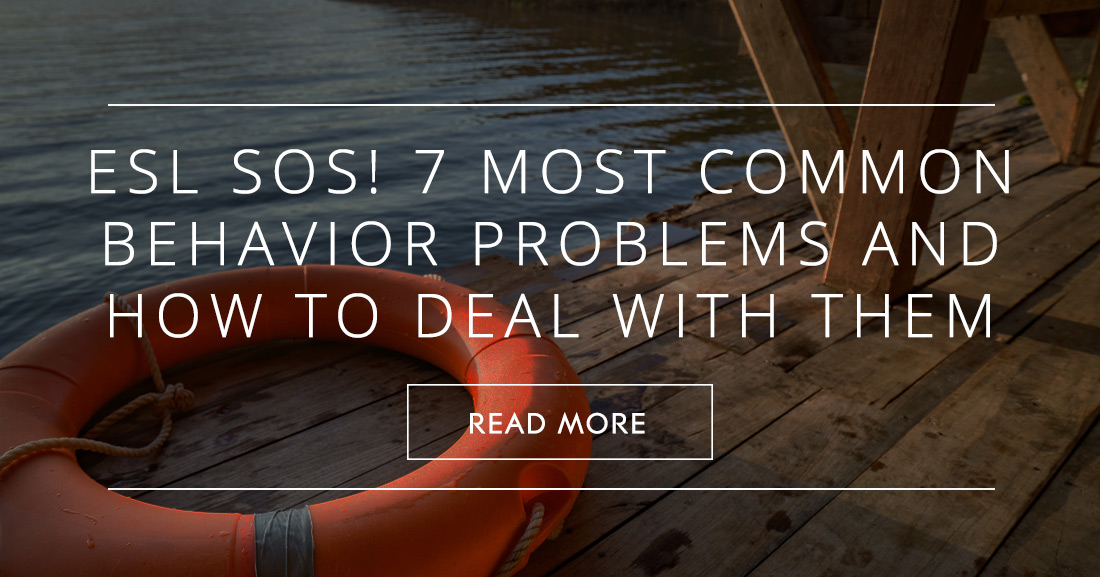ESL students come in all shapes and sizes.
They come into your classroom with varying degrees of motivation and even different skill levels. Most are well-behaved. And some are terribly ill-behaved. As an ESL teacher, you can handle students that are less motivated than most, even those that need a little extra help from you to get that particular task done. But we all know that handling unacceptable behavior is hard and can take its toll if it is something you have to deal with on a daily basis.
The way we handle the day-to-day problems will determine whether the same problems will keep cropping up. So here are the most common behavior problems in the ESL class and how you can effectively nip them in the bud.

Unacceptable Behavior: 7 Problems and How to Handle Them
-
1
Students Are Restless/Get Out of Seat
EXAMPLE: You’re having an animated discussion about ways to help the environment and a student gets up to look out the window.
Always give clear instructions, and make sure everyone understands and is engaged in the task. As soon as a student gets up to do something completely unrelated, walk over to the child, gently take their hand and walk them back to their seat – without interrupting the lesson. If this behavior continues, talk to them about the importance of paying attention, participating in the activity at hand and controlling the urge to do something else.
-
2
Playing with Toys during Class
EXAMPLE: Students are quietly completing a worksheet about parts of the body when you see a student playing with a doll.
Gently take the toy, and place it on your desk or a shelf. Tell the child that they can share it with the others during the break. Make it a habit of encouraging them to bring toys related to something you’re talking about in class (like animals). If there are certain things they are allowed to bring, they might not feel tempted to bring other toys.
-
3
Name Calling
EXAMPLE: You’re playing Bingo when you hear a student call a redheaded child “Carrot Top”.
Stop what you’re doing and have the child that has called out the offending name tell the class what the other student’s name actually is. Discuss with the class the importance of treating each other with respect and kindness and why name calling is unacceptable in your classroom and everywhere else, for that matter.
-
4
Teasing/Fighting/Bickering
EXAMPLE: You have two students who can’t say two words to each other without starting a fight. Class began five minutes ago, and they’re already at each other’s throats.
Make sure the students who don’t get along are sitting as far apart as possible. Discuss with the class the importance of ignoring teasing remarks. Talk about how arguing all the time is tiresome, and we should accept differences in points of view. On the other hand, stress the importance of being considerate towards each other and listening to what the other has to say.
-
5
Throwing Things
EXAMPLE: You’re writing something on the whiteboard and a pencil flies across the room.
Tell the student that this kind of behavior is completely unacceptable. Go over the possible dangers of tossing objects around. Find out if they are doing what they’re supposed to be doing and redirect their efforts to the task at hand.
-
6
Yelling/Shouting Out Answers
EXAMPLE: You ask Tom a question, and Lucy yells out the answer.
Tell the student that they’re not being courteous – they did not give the other student a chance to answer. Remind students they should raise their hands if they want to speak. On the other hand, remind them that it is not necessary to yell – if they wait their turn to speak, you will hear them perfectly.
-
7
Having Private Conversations
EXAMPLE: You’re asking students comprehension questions about a text they’ve just read, and you see three students in the back of the class holding a conversation.
Ask the students if they are talking about the task at hand. Ask them to share their interesting conversation with the rest of the class, or tell them they can tell the others all about it during the break. Discuss why it is not appropriate to have conversations during class.

When to Talk to Parents
As a good rule of thumb, I recommend contacting parents when a specific problem seems to be recurring (happens every day or several times a week). Depending on the gravity of the matter, you can either send a note or schedule a meeting. I’d save meetings for things that put the children’s well-being at risk, for instance violent behavior, verbal abuse or bullying.
There’s a line between being mischievous and being outright malicious, and we can tell the difference. You can deal with mischievous behavior in class – malicious behavior should be discussed with parents.

Prevention is the Best Medicine
Most of these problems will be avoided if you set clear rules from the start. Work together to establish your rules based on how you all want to be treated. Discuss the importance of treating others with respect, as well as the fact there is a time and place for everything and that some things simply can’t be done in class. Don’t forget to establish what rewards they will receive for good behavior, as well as the consequences of inappropriate behavior.
Don’t yell, scream or shout. The best way to teach students to behave nicely is to lead by example.
If you’ve ever encountered problems like these or others, tell us how you dealt with them below!
P.S. If you enjoyed this article, please help spread it by clicking one of those sharing buttons below. And if you are interested in more, you should follow our Facebook page where we share more about creative, non-boring ways to teach English.







